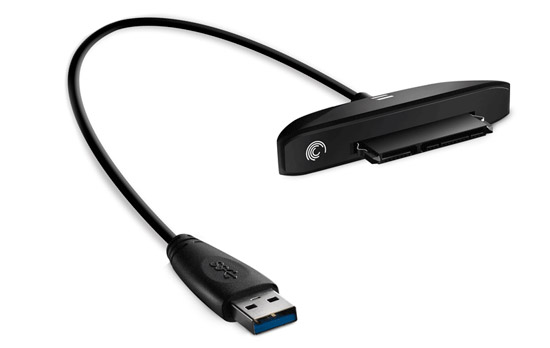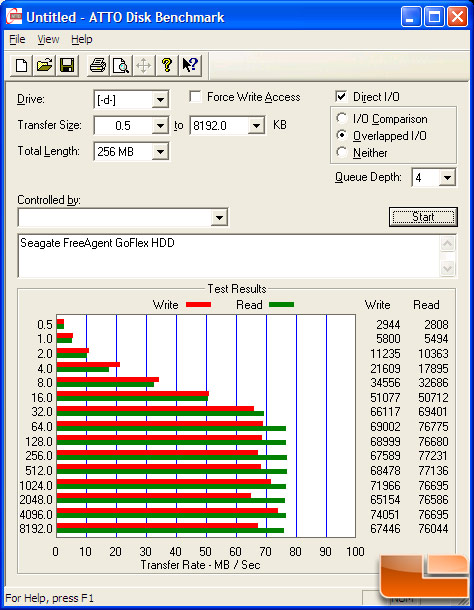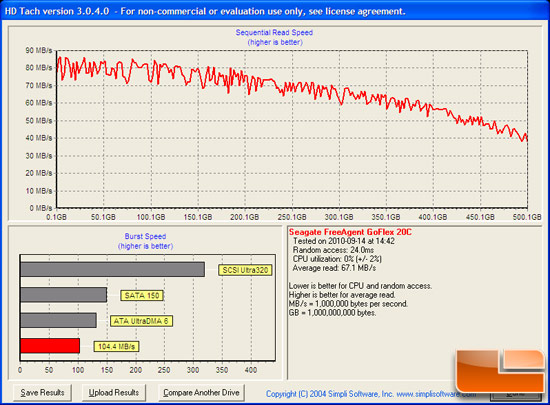Seagate FreeAgent GoFlex TV HD Media Player Review
The New FreeAgent Form Factor
The GoFlex TV is obviously designed around the all-new GoFlex Ultra-Portable Hard Drive. We wanted to take a quick look at this drive to see what you are really getting. For those people who have already invested in Seagates older FreeAgent, there should be a good reason to jump ship and pick up a totally new form factor.
The basic premise of Seagates new line of hard drives is to allow the user flexibility to use the drives in almost any environment. Yes, most external hard drives support USB 2.0, but how many have the capability to go from USB 2.0 to USB 3.0 to FireWire 800, or power eSATA. The GoFlex can do that with the proper cable selection. So now you can have the highest speed drive no matter what hardware platform you need to support.

The GoFlex Portable Drive comes in either 320GB, 500GB, 750GB or 1TB sizes. Retail prices start at $89 for the 320GB and go up to $169 for the 1TB drive. These prices arent that bad, but these prices only include a cable connection good enough for USB 2.0 speeds. If you want USB 3.0 (or eSATA, FireWire 800), you need to buy the “Upgrade Cables”. The FireWire Upgrade Cable retails for $39.99. The USB 3.0 is a little bit cheaper at $29.99, and the eSATA cable is $19.99.
Seagate also sells bundles these cables in different cable/HDD configurations and kits. Lets see how well the GoFlex Hard Drive did on some quick benchmark tests. We used our Dell Latitude E4200 as our test system for these benchmarks. The Latitude runs an Intel U9400 Core 2 Duo at 1.4GHz with 3Gb of RAM. Finally, it is equipped with an 128GB Samsung SSD running Windows XP Professional (SP3).
We used ATTO version 2.46 to measure transfers across a specific volume length. The benchmark measures raw transfer rates for both reads and writes and places the data into graphs that can be very easily interpreted. The test was run with the default runs of 0.5kb through 8192kb transfer sizes with the total length being 256MB.

Benchmark Results: We were able to reach about 78MBps on the Read Test which are a long way from any SSD or internal hard drive we have tested, but they are even off for USB 3.0 drives we have evaluated in the past. I was really hoping for Read speeds faster than 100MBps.
Next, we ran CrystalDiskMark version 2.2.0 which is a hard drive benchmark utility that enables you to rapidly measure sequential and random read/write speeds. We ran our of our CrystalDiskmark tests using a 100MB file size.

Benchmark Results: Our top speed was confirmed as we got 77MBps read speeds and 71MBps. This is about double what we would expect from a USB 2.0 drive, but again, we were hoping for a little better performance from the GoFlex.
The last benchmark we ran was HD Tack version 3.0.4.0. HD Tach is a low level hardware benchmark for random access read/write storage devices such as hard drives, removable drives (ZIP/JAZZ), flash devices, and RAID arrays. HD Tach uses custom device drivers and other low level Windows interfaces to bypass as many layers of software as possible and get as close to the physical performance of the device possible.

Benchmark Results: Even though our burst speed measurement increased to over 100MBps, on average, the GoFlex hard drive still performed below average at under 70MBps. Lets hope that these speeds dont affect the playability or data transfer when using the GoFlex TV.

Comments are closed.